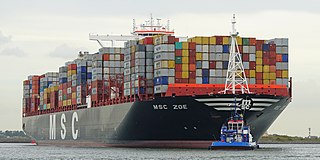
Maritime transport or more generally waterborne transport, is the transport of people (passengers) or goods (cargo) via waterways. Freight transport by sea has been widely used throughout recorded history. The advent of aviation has diminished the importance of sea travel for passengers, though it is still popular for short trips and pleasure cruises. Transport by water is cheaper than transport by air or ground, but significantly slower for longer distances. Maritime transport accounts for roughly 80% of international trade, according to UNCTAD in 2020.

Containerization is a system of intermodal freight transport using intermodal containers. Containerization, also referred as container stuffing or container loading, is the process of unitization of cargoes in exports. Containerization is the predominant form of unitization of export cargoes, as opposed to other systems such as the barge system or palletization. The containers have standardized dimensions. They can be loaded and unloaded, stacked, transported efficiently over long distances, and transferred from one mode of transport to another—container ships, rail transport flatcars, and semi-trailer trucks—without being opened. The handling system is completely mechanized so that all handling is done with cranes and special forklift trucks. All containers are numbered and tracked using computerized systems.
Cable-Satellite Public Affairs Network is an American cable and satellite television network, created in 1979 by the cable television industry as a nonprofit public service. It televises proceedings of the United States federal government and other public affairs programming. C-SPAN is a private, nonprofit organization funded by its cable and satellite affiliates. It does not have advertisements on any of its networks or radio stations, nor does it solicit donations or pledges. The network operates independently; the cable industry and the U.S. Congress have no control over its programming content.

An intermodal container, often called a shipping container or ISO Container, is a large standardized container designed and built for intermodal freight transport, meaning these containers can be used across different modes of transport – from ship to rail to truck – without unloading and reloading their cargo. Intermodal containers are primarily used to store and transport materials and products efficiently and securely in the global containerized intermodal freight transport system, but smaller numbers are in regional use as well. These containers are known under a number of names. Based on size alone, up to 95% of intermodal containers comply with ISO standards, and can officially be called ISO containers. Many other names are simply: container, cargo or freight container, shipping, sea or ocean container, container van or sea van, sea can or C can, or MILVAN, SEAVAN, or RO/RO. The also used term CONEX (Box) is technically incorrect carry-over usage of the name of an important predecessor of the international ISO containers, namely the much smaller prior steel CONEX boxes used by the U.S. Army.

A container ship is a cargo ship that carries all of its load in truck-size intermodal containers, in a technique called containerization. Container ships are a common means of commercial intermodal freight transport and now carry most seagoing non-bulk cargo.

The Port of Los Angeles is a seaport managed by the Los Angeles Harbor Department, a unit of the City of Los Angeles. It occupies 7,500 acres (3,000 ha) of land and water with 43 miles (69 km) of waterfront and adjoins the separate Port of Long Beach. Promoted as "America's Port", the port is located in San Pedro Bay in the San Pedro and Wilmington neighborhoods of Los Angeles, approximately 20 miles (32 km) south of downtown.

Tang is an American drink mix brand that was formulated by General Foods Corporation food scientist William A. Mitchell and General Foods Corporation chemist William Bruce James in 1957, and first marketed in powdered form in 1959. The Tang brand is currently owned in most countries by Mondelēz International, a North American company spun off from Kraft Foods in 2012. Kraft Heinz owns the Tang brand in North America.

Mediterranean Shipping Company S.A. (MSC) is an international shipping line founded by Gianluigi Aponte in Italy in 1970, with headquarters in Switzerland since 1978. The privately held company is owned by the Aponte family. The company operates in all major ports of the world.

Evergreen Marine Corporation is a Taiwanese container transportation and shipping company that is headquartered in Luzhu District, Taoyuan City, Taiwan. With over 150 container ships, it is part of the Evergreen Group conglomerate of transportation firms and associated companies.

Orient Overseas Container Line, commonly known as OOCL, is a container shipping and logistics service company with headquarters in Hong Kong. The company is incorporated in Hong Kong as Orient Overseas Container Line Limited and separately incorporated as Orient Overseas Container Line Inc. in Liberia. The latter was also re-domiciled to the Marshall Islands.

HMM Company Limited, formerly known as Hyundai Merchant Marine, is a South Korean container transportation and shipping company.
The Box: How the Shipping Container Made the World Smaller and the World Economy Bigger is a non-fiction book by Marc Levinson charting the historic rise of the intermodal container and how it changed the economic landscape of the global economy. The New York Times called it "a smart, engaging book".

SS Ideal X, a converted World War II T-2 oil tanker, was the first commercially successful container ship.
The International Consortium of Investigative Journalists, Inc. (ICIJ), is an independent global network of 280 investigative journalists and over 140 media organizations spanning more than 100 countries. It is based in Washington, D.C., with personnel in Australia, France, Spain, Hungary, Serbia, Belgium and Ireland.

Maersk Line is a Danish international container shipping company and the largest operating subsidiary of Maersk, a Danish business conglomerate. Founded in 1928, it is the world's second largest container shipping company by both fleet size and cargo capacity, offering regular services to 374 ports in 116 countries. In 2019, it employed 83,625 people where 18,398 of which are vessel crew and the other 65,227 are processing and operations personnel in offices and ports.

Sazmanab is a curatorial project which originally started as an artist-run space and residency program in Tehran in 2008. Sazmanab supported artistic work in a wide range of media through exhibitions and events, residencies for artists and curators, workshops, talks, and other events.

The Museum for the United Nations — UN Live is a global institution based in Copenhagen. Its mission is to “unleash the power of culture to inspire local action and drive global change”. UN Live describes itself as an unconventional and borderless museum that seeks to reach and connect people on a global scale to the values and work of the United Nations. While formally stewarding the brand of the United Nations, UN Live is an independent institution.

Portals is a global public art initiative that connects people around the globe through real-time video audiovisual technology housed inside a gold-painted, converted shipping container or other structure. Individuals and groups enter local Portals and engage with individuals or groups in distant Portals through live, full-body video conferencing. The experience has been described as "breathing the same air." Portals are placed in public spaces such as public squares, museums, university campuses, high-level summits, and refugee camps. Participation is free, and the spaces are maintained by staff called Portal_Curators.

COSCO SHIPPING Lines Co., Ltd. is a Chinese international container transportation and shipping company. It is a subsidiary of COSCO Shipping Holdings, and its parent company is China's state-owned COSCO Shipping.
















